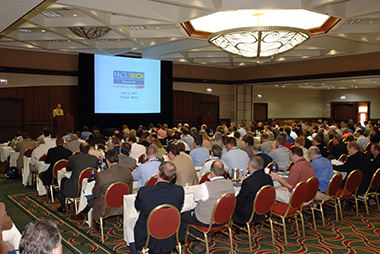 I joined NACS almost 19 years ago (Feb. 28, 2005, to be exact). My first NACS event was marketed as “the most comprehensive collection of firm-level, store-level and same-store-level data and trends based on the convenience store industry’s performance.” Yep, no clue what this meant, but I was going.
I joined NACS almost 19 years ago (Feb. 28, 2005, to be exact). My first NACS event was marketed as “the most comprehensive collection of firm-level, store-level and same-store-level data and trends based on the convenience store industry’s performance.” Yep, no clue what this meant, but I was going.
Here’s what I remember: Bob Swanson, our former NACS director of research and statistics, was in the office next to mine, and he was on the phone a lot…like, a lot. His team was busy collecting data, crunching numbers and preparing decks of data for the 2005 NACS State of the Industry (SOI) Summit.
That 2005 SOI Summit was my shot-out-of-the-cannon entry into the world of convenience retail. I was about to learn a lot about what goes on in stores.
“A strong 17.1% growth in sales helped the convenience store industry set record revenues of $394.7 billion in 2004, while profits shot up 23.5% to reach $4.99 billion,” we wrote in the June 2005 issue of NACS Magazine—the same issue that featured an interview with then-NACS President Kerley LaBeouf, who was passing the torch to incoming NACS President and CEO Henry Armour.
The article explained that revenue growth in 2004 “was largely driven by higher gasoline prices. And while overall profits continued to rebound from the three-year slide experienced from 2000 to 2002, margins for motor fuels dropped a cent and credit card fees continued to escalate.”
Both issues are relevant today—especially card fees. In 2004, credit card fees were 0.8% of total industry sales, or about $3.2 billion. Those sky-high card fees (they ballooned to a ridiculous $19.5 billion by 2022) fueled a retail industry milestone in 2005: The Merchants Payments Coalition formed with other retail-focused associations, led by the late and beloved industry champion, Teri Richman.
Our 2005 SOI Summit coverage had an interesting observation about packaged beverages: “This category always provides a challenge to operators who must balance a constant lack of space with the plethora of new product offerings.” While some category management issues may persist, retailers are solving many of them because the c-store industry today owns this category: Pack bevs were 17.2% of total in-store sales with a gross margin contribution of 21% in 2022.
Going back to foodservice, we heard that the category, which represented almost 12% of in-store sales in 2004, was going to be the future. And they were right: Foodservice sales have more than doubled their share of in-store revenues—more than 26%—by 2022.
The look back at the numbers shows how emerging trends can ultimately take off and redefine our industry—or even retail overall. Comparing industry data over time can also help predict whether a fad can turn into a trend.
So, what’s next? What changes could affect your operation in the coming years? As I’ve experienced in the past (almost) two decades, the upcoming NACS State of the Industry Summit is the industry’s first look at where the industry has been and where it’s heading.
Who knows, if I’m still at NACS in 19 years I’ll revisit this blog and see where we’re at—although I hope to be retired by then! As for today, we look forward to seeing you April 3-5 at the NACS SOI Summit in Chicago.